orange hawkweed
(Pilosella aurantiaca)
Conservation • Weed • Description • Habitat • Ecology • Use • Distribution • Taxonomy
Description |
||
Orange hawkweed is an erect, perennial forb that rises on a rosette of basal leaves and a single flowering stem from a long or short, horizontal, underground stem (rhizome) and shallow fibrous roots. It is usually 6″ to 14″ tall at maturity, though some individuals may reach 24″ or more in height. It reproduces mostly by producing 4 to 12 aboveground runners (stolons) that creep along the ground and produce a new plant at the tip. The stolons are leafy and 4″ to 12″ long. It sometimes forms dense mats. Stems and leaves, when broken, exude a milky juice. The basal rosette consists of 3 to 8 leaves. Basal leaves are spatula-shaped to inversely lance-shaped, 1¾″ to 8″ long including the leaf stalk, and ⅜″to 1⅜″wide, 3 to 5 or more times longer than wide. Most leaves are no more than 2¾″ long. The leaf blades are wedge-shaped at the base and blunt at the tip. The upper and lower surfaces are covered with long, soft, straight hairs and short, branched, star-shaped hairs. The margins are untoothed. Basal leaves are present at flowering time. A single unbranched flowering stalk rises from the center of the rosette. The stem is covered with 1 ⁄32″ to ⅛″ long soft, straight hairs. Toward the top it is also covered with star-shaped hairs and stalked glands. There is sometimes as single leaf, rarely 2 leaves, on the stem. Stem leaves are similar to basal leaves but smaller. The inflorescence is a branched, compact, more or less umbrella-like array of flower heads at the end of the stem. There are usually 3 to 7, sometimes up to 12, flower heads in the array. There is a whorl of 13 to 30 or more lance-shaped to linear bracts at the base of the flower head (involucre). The involucre is 3 ⁄16″to 5 ⁄16″ long and bell-shaped. The bracts of the involucre (phyllaries) are covered with long, soft, straight hairs; short, branched, star-shaped hairs; and stalked glands. Each flower head is ¾″ to 1″ in diameter, has 25 to 120 or more ray florets, and has no disk florets. The ray florets are ⅜″ to 9 ⁄16″ long and orange to reddish-orange. Rays near the center of the flower head are usually yellow, at least near the base. The flowers appear from May to August, peaking in June. When they dry they become scarlet or purple. The fruit is a 1 ⁄32″ to 1 ⁄16″ long, single-seeded capsule (cypsela). The cypsela is round in cross section and narrowed at the base. It has 10 longitudinal ribs and a tuft of 25 to 30 or more white, barbed bristles attached to the end. It is dispersed by wind. |
||
Height |
||
6″ to 24″ |
||
Flower Color |
||
Orange to red |
||
Similar Species |
||
No similar species. This is the only hawkweed with orange flower heads. |
||
Habitat |
||
A variety of habitats, including grasslands, forests, and wetlands, bogs, fields, roadsides, meadows, disturbed sites. |
||
Ecology |
||
Flowering |
||
May to August |
||
Allelopathy |
||
Pollen allelopathy occurs when the pollen of one species is transferred to another species. The transferred pollen then releases toxins which interfere with the growth of pollen tubes, the receptivity of the stigma or style, respiration, germination or growth of the seedling, production of chlorophyll in leaves, or production of seeds. Orange hawkweed is one of the six known pollen allelopathic plants. |
||
Pests and Diseases |
||
|
||
Use |
||
|
||
Distribution |
||||
|
Sources |
|||
Nativity |
||||
Native to northern and central Europe. Introduced as an ornamental to Vermont before 1875. Escaped cultivation many times. Now naturalized in North America. |
||||
Occurrence |
||||
Widespread but sporadic |
||||
Taxonomy |
|||
| Kingdom | Plantae (Plants) | ||
| Division | Tracheophyta (Vascular Plants) | ||
| Subdivision | Spermatophytina (Seed Plants) | ||
| Class | Magnoliopsida (Dicots) | ||
Order |
Asterales (Sunflowers, Bellflowers, Fanflowers, and Allies) | ||
Family |
Asteraceae (Sunflowers, Daisies, Asters, and Allies) | ||
| Subfamily | Cichorioideae (chicories, dandelions, and allies) | ||
| Tribe | Cichorieae (lettuce, chicory, dandelion, and salsify) | ||
| Subtribe | Hieraciinae (hawkweeds) | ||
| Genus | Pilosella (mouse ear hawkweeds) | ||
Until recently, plants in the genus Pilosella were grouped as a subgenus of Hieracium. Distinct features of the cypsela, absence of hybridization between groups, and, in some species, the presence of runners (stolons) and/or red lines on the lower (abaxial) ligule surface, support the segregation of these species into a separate genus. |
|||
Subordinate Taxa |
|||
|
|||
Synonyms |
|||
Hieracium aurantiacum |
|||
Common Names |
|||
devil’s-paintbrush fox-and-cubs grim-the-collier orange hawkweed orange king-devil red daisy |
|||
Glossary
Allelopathy
The release of a chemical toxin by one plant to inhibit the growth or germination of nearby competing plants.
Bract
Modified leaf at the base of a flower stalk, flower cluster, or inflorescence.
Cypsela
A dry, one-chambered, single-seeded seed capsule, formed from a single carpel, with the seed attached to the membranous outer layer (wall) only by the seed stalk; the wall, formed from the wall of the inferior ovary and also from other tissues derived from the receptacle or hypanthium, does not split open at maturity, but relies on decay or predation to release the contents.
Involucre
A whorl of bracts beneath or surrounding a flower, flower head, or flower cluster.
Linear
Long, straight, and narrow, with more or less parallel sides, like a blade of grass.
Phyllary
An individual bract within the involucre of a plant in the Asteraceae family.
Rhizome
A horizontal, usually underground stem. It serves as a reproductive structure, producing roots below and shoots above at the nodes.
Stolon
An above-ground, creeping stem that grows along the ground and produces roots and sometimes new plants at its nodes. A runner.
Visitor Photos |
|||||
Share your photo of this plant. |
|||||
| This button not working for you? Simply email us at info@MinnesotaSeasons.com. Attach one or more photos and, if you like, a caption. |
|||||
Bill Reynolds |
|||||
The hawkweed grew in great abundance in my yard in St Louis Co. My honeybees only gathered from the hawkweed in years there wasn't much else blooming. The Tansy was another one they wouldn't use much. |
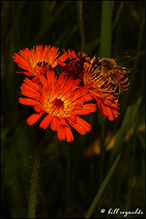 |
||||
Ed Oliveras |
|||||
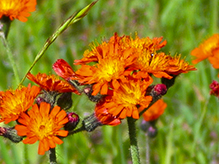 |
|||||
MinnesotaSeasons.com Photos |
|||||
Plant |
|||||
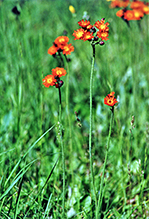 |
|||||
Inflorescence |
|||||
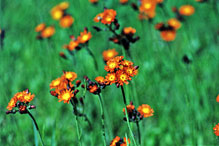 |
|||||
Flower Head |
|||||
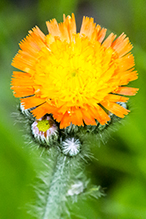 |
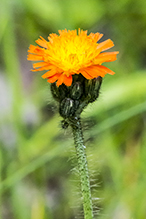 |
||||

Slideshows |
||
| Orange Hawkweed or Devil's Paintbrush (Hieracium aurantiacum) Andree Reno Sanborn |
||
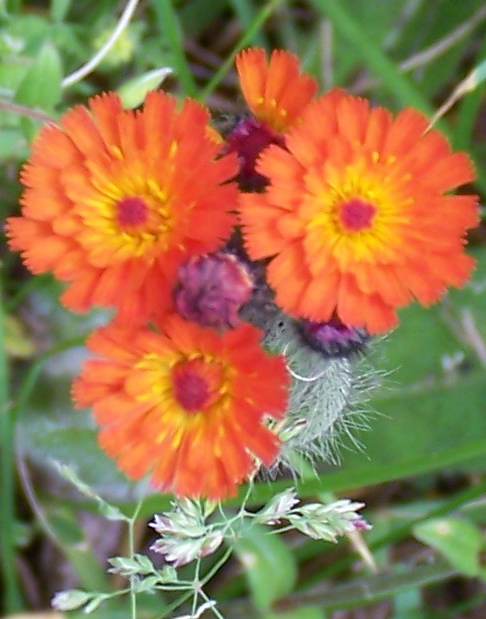
|
||
About
s "orange hawkweed" "devil's paintbrush" |
||
| Folk po našem * Sober Folk drnespor |
||
About
Published on Jun 18, 2012 Cz: Květinou je Jestřábník oranžový (Hieracium aurantiacum) a interprety písně Vždystřízlivci se skvělým sólistou. www.drnespor.eu: Svépomocné příručky, relaxační nahrávky, smích atd. Oblíbená jóga: www.biharyoga.net. Oblíbený čchi-kung: www.zy-qigong.cz, www.zyq.sk. Svépomoc: www.anonymnialkoholici.cz. AZ! Vše dobré! English: Enjoy! Original recording of a folk song by Weversober. The flower is orange hawkweed or Hieracium aurantiacum. www.drnespor.eu: Papers, relaxation recordings, laughter, etc. My Favorite Yoga: www.biharyoga.net. My Favorite Qigong: www.springforestqigong.com, www.zyqigong.org. Self-help: www.aa.org. Best Wishes! |
||

Visitor Videos |
|||
Share your video of this plant. |
|||
| This button not working for you? Simply email us at info@MinnesotaSeasons.com. Attach a video, a YouTube link, or a cloud storage link. |
|||
Other Videos |
|||
| Unwanted: Orange Hawkweed in Bend Bend Bulletin |
|||
About
Published on Jun 15, 2012 Dan Sherwin, vegetation manager for Deschutes County, describes why the county wants to find and kill orange hawkweed. The pretty plant is an invasive weed. |
|||
| Orange Hawkweed (Pilosella Aurantiaca) / Fox-and-cubs - 2012-06-12 W3stlander |
|||
About
Published on Jun 18, 2012 Pilosella aurantiaca (Fox-and-cubs, Orange Hawkweed,[2]:208 Tawny Hawkweed, Devil's Paintbrush, Grim-the-collier) is a flowering plant of the family Asteraceae. Oranje havikskruid (Hieracium aurantiacum, synoniem: Pilosella aurantiaca) is een vaste plant die behoort tot de composietenfamilie (Asteraceae). Dit exemplaar is bijna zeker verwilderd uit het nabijgelegen volkstuinencomplex "Ons Ideaal", daar staan er meer. |
|||
| Orange Hawkweed flowers on my field [July 7, 2012 13:06] Tim Acheson |
|||
About
Published on Jul 10, 2012 A patch of wild Orange Hawkweed flowers on my hay meadow in Braughing. This weed is also known as "Devil's Paintbrush" or "Fox and Cubs". (Hieracium aurantiacum, syn. Pilosella aurantiaca.) At first glance the bloom looks a bit like an miniature gerbera or anemone. Photo: https://www.dropbox.com/s/mg87pl628o8hvkn/2012-07-07%2013.09.09.jpg |
|||

Visitor Sightings |
|||||
Report a sighting of this plant. |
|||||
| This button not working for you? Simply email us at info@MinnesotaSeasons.com. Be sure to include a location. |
|||||
| Ed Oliveras 6/24/2004 |
Location: St. Croix State Park |
 |
|||
| Bill Reynolds 6/23/2004 |
Location: St Louis Co. The hawkweed grew in great abundance in my yard in St Louis Co. My honeybees only gathered from the hawkweed in years there wasn't much else blooming. The Tansy was another one they wouldn't use much. |
 |
|||
MinnesotaSeasons.com Sightings |
|||||

|
Created: Last Updated: © MinnesotaSeasons.com. All rights reserved. |
